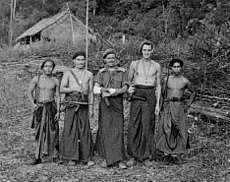Operation Agas
Operation Agas was a series of reconnaissance operations carried out by Australia's Z Special Unit during World War II. This operation was the part of the Borneo Campaign at North Borneo (present day Sabah). Another closely related operation codenamed Semut was carried out in Sarawak. Both operations combined and relayed their intelligence through the STALLION project to Australian forces and carried out guerilla warfares against the Japanese in the region with the full support of the natives.[1]
Execution

Prior to this operation, Operation Python was carried out at Labian Point, Lahad Datu, North Borneo. Following this, operation AGAS was carried out in 1945 by Australian Services Reconnaissance Department (SRD) with two main objectives: to gather intelligence and to train the indigenous people in launching guerilla warfare against the Japanese.[2]
In March 1945, Major F. G. L. Chester, who led the Operation Python 1 previously, landed at the Labuk Bay, Sandakan. A central signal station was established at Lokopas and a hospital was established at Jambongan Island for the natives. Information such as train schedule to and from Beaufort, cargo movements, timber collection was the railway operations were collected. AGAS 1 made contact with two Chinese men named Chin Sang and Ah Lee. They refused long-term cooperation with AGAS 1 members but willing to provide the details of Japanese movements in the area.[2]
Two months later, AGAS 2 led by Major R. G. P. N. Combe landed at Paitan Bay, Sandakan. They set up an intelligence network and guerilla activities at the Pitas, Kudat.[2]
AGAS 3, also led by Chester, focussed its activities at Jesselton-Keningau-Beaufort sector. AGAS 3 was later incorporated into the STALLION Phase IV network, an intelligence sharing network between Semut and AGAS. The STALLION Phase IV project focused their reconnaissance on the Kimanis Bay area.[2]
Impact
Overall, AGAS operation was able to supply reliable information to Australian forces. The total estimated number of Japanese troops reported at 31,000 in May 1945 was not too far off the official number given in October 1945 (35,000). It also provided the crucial information that the overall Japanese movements was to evacuate the coast and moving into the North Borneo interior.[2]
Alan Powell concluded that "Agas succeeded politically, had little direct military value and failed as a POW rescue operation". This was due to the general "apathy, fear, and the desire to return home" expressed by the local guerilla units after the failed 1943 Jesselton Revolt. This has prevented guerilla force to launch significant attacks against the retreating Japanese. AGAS 1, although provided information about the movements of Sandakan Death March, they did not execute any rescue missions for the POWs (prisoner of war).[2]
AGAS 1 had provided useful intelligence on guiding a successful bombing raids at Sandakan. It also trained 250 people of native guerilla force. More than 2,000 native inhabitants had benefited from the hospital set up by AGAS 1.[2]
AGAS 2 also successfully set up a native guerilla force of 150 to 250 people strong and had a successful contact with Chinese guerillas at Kota Belud. It also set up a hospital at Lokopas area for the natives.[2]
Meanwhile, for AGAS 3, it was unable to accomplish many of its objectives due to high concentration of Japanese troops in the area, which numbered to 6,000 troops between Jesselton and Beaufort. The Chinese in this region also refused any cooperation because of their fear of retaliation after a failed Jesselton Revolt in 1943. Intelligence gathered from this region has avoided a head-on clash with the enemy during the Operation Oboe Six (Battle of North Borneo).[2]
References
- ↑ "Remembering Operation Semut". The Borneo Post SEEDS. BPOnline. Retrieved 15 September 2015.
- 1 2 3 4 5 6 7 8 9 Gin, Ooi Keat (October 2002). "Prelude to Invasion: Covert Operations Before the Re-occupation of Northwest Borneo, 1944–45". Journal of the Australian War Memorial. Canberra: Australian War Memorial (37). ISSN 1327-0141. Retrieved 2 November 2014.
Further reading
- Powell, Alan (1996). War by Stealth: Australians and the Allied Intelligence Bureau, 1942–1945. Melbourne: Melbourne University Press. ISBN 0-522-84691-2.